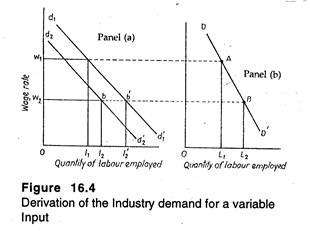The below mentioned article provides a quick notes on Input Demand by a Competitive Industry.
Any one competitive firm can vary its level of any input usage in response to a change in its price and can therefore vary output without affecting the price of the commodity produced.
However, when all firms respond to a change in the price of an input by changing the level of usage of the input, commodity price (i.e., the price of their output) will either rise or fall. Since each firm’s demand for the input is derived holding commodity price constant, all firms’ input demand curves shift when all firms vary the quantity of the variable factor.
Suppose once again that labour is the variable input (although all of the following assumptions hold for any input). Let’s suppose that a typical firm having only labour as a variable input is depicted in Figure 16.4, Panel (a).
ADVERTISEMENTS:
At the prevailing market price of the commodity produced, d1d1 is the firm’s demand curve for labour. If the market wage rate is w1, the firm uses l1 units of labour. Adding up the labour demands of all the firms belonging to the industry, we get industry demand for labour — L1 units of labour are employed by the industry as a whole. Thus, we locate point A in Panel (b) as one point on the industry demand curve for labour.
Next, suppose the price of labour (or wage rate) falls to All other things remaining constant, the individual firm would move along d1d2 to b’ and would employ l2 units of labour. But, other things do not remain unchanged. When all firms expand their use of the input, total output increases.
Differently put, the market supply curve for the commodity shifts to the right because of the fall in the wage rate. For a given commodity demand, commodity price must fall; and when this happens, the individual demand curve for labour – the VMP curve – shifts to the left.
ADVERTISEMENTS:
In Panel (a), the fall in individual input demand attributable to the fall in commodity price is represented by the leftward shift from d1d1 to d2d2 signifying a fall in VMP. When wage rate is w2, b is the equilibrium point, with units employed.
Aggregating for all employers, we observe that L2 units of labour are used. (Point B is obtained in Panel (b)). Any number of points such as A and B can be generated by varying the market wage rate. The locus of all such points, DD’, is the industry demand curve for labour which has to be negatively sloped.
Thus, the wage rate that firms in the industry must pay for any type of labour is determined by market forces, i.e., by supply of, and demand for that category of labour. This is true of any other factor input.
The market (total) supply of the input would be positively sloped, since additional units of the input – say, some type of labour – must be diverted from other occupations, by paying extra wages. For example, if the contraction industry in a particular area wants to hire more carpenters, the added carpenters must be bid away from other areas by paying higher wages.
ADVERTISEMENTS:
The supply and demand in the market together determine the wage rate that firms in the industry must pay. Anything that increases (decreases) the demand for the input must increase (decrease) its market price, i.e., the price which an individual firm has to pay for the input.
